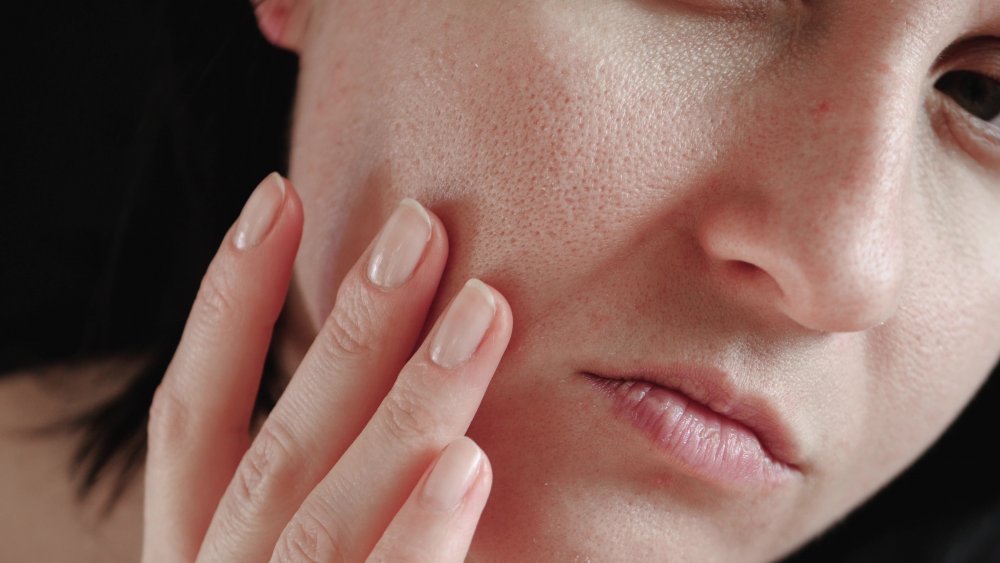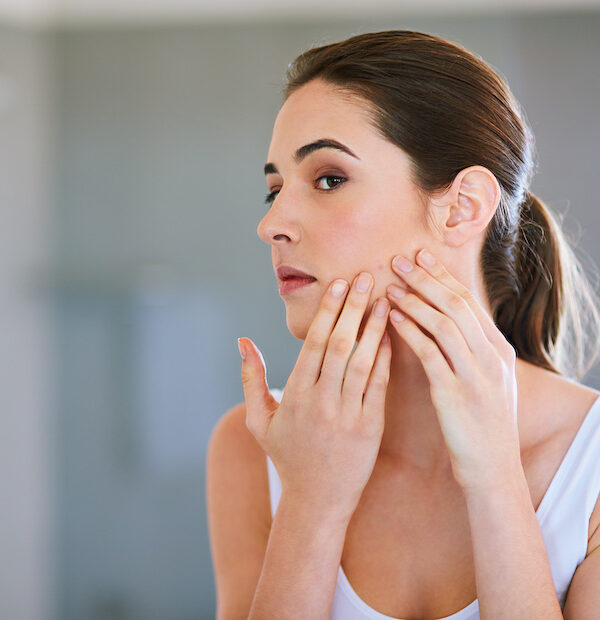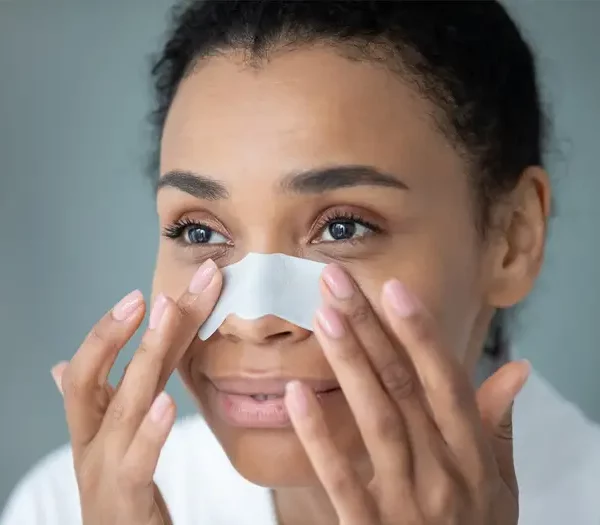What are clogged pores?
Clogged pores refer to a skin condition where the skin’s natural openings which are called pores, get obstructed due to factors such as dead skin cells, dirt, oil, and other impurities. This blockages can cause various skin problems such as acne breakouts, blackheads, and whiteheads, and make the skin look very dull and rough. Clogged pores are the outcome of various reasons, such as excessive oil production, some hormonal changes, environmental factors, and improper followed skincare practices. It is quite necessary to keep the pores clean and unclogged so that healthy skin is maintained. Some good skin care practices such has regular exfoliation, cleansing, and moisturizing can help in preventing clogged pores and keep the skin looking fresh, glowing and radiant.
What do clogged pores look like?
Clogged pores are generally dark in color (red, black) and are generally large and bumpy spots on skin.
Is clogged pores dry or oily skin?
Clogged pores are more common on oily skin but dry skin can also experience clogged pores. Sometimes, Dry or rough skin can look like clogged skin due to rough skin texture.
Also see: Tips to Remove Face Scars at Home
Causes of Clogged Pores on Face
Clogged pores on the face can be a very annoying, frustrating and common skin problem for many people. While in general clogged pores are not harmful to your health, they can look ugly, be unsightly and can lead to other skin issues, such as blackheads, whiteheads, acne, and dull-looking skin. Understanding the causes of clogged pores in detail can help you take steps to prevent and treat them effectively.
1. Excessive Oil Production: Excessive oil production is one of the most common causes and in fact the major cause of clogged pores. When the skin produces too much oil, it has a tendency to mix with dead skin cells, dirt, and other impurities, forming a plug in the pores. This plug can make the pores to become inflamed which leads to the formation of pimples, blackheads, or whiteheads.
2. Hormonal Changes: Hormonal changes are also an important cause of clogged pores. During puberty, for instance, hormone levels increase that leads to an increase in oil production. This can cause the pores to become clogged, leading to the formation of acne and other adverse skin conditions.
3. Poor Skin Care: Poor skin care habits can also lead to clogged pores. Failure in cleaning the skin regularly or using harsh cleansers can strip the skin of its natural oils which leads to an overproduction of oil to compensate. This excess oil can then combine with other impurities, clogging the pores.
4. Environmental Factors: Some Eenvironmental factors namely, pollution, can also contribute to clogged pores.
5. Lifestyle Habits: Certain lifestyle habits, such as smoking etc., can also contribute to clogged pores. We all know that smoking can damage the skin and cause it to produce more oil, leading to the formation of clogged pores.
6. Makeup and Cosmetics: If you wear heavy makeup or cosmetics then it can also contribute to clogged pores. Some ingredients in these products can cause the skin to become irritated, leading to inflammation and clogged pores.
7. Genetics: Genetics can also play a major role in the development of clogged pores. People who have oily skin tend to be more prone to clogged pores, as their skin produces more oil.
Difference between enlarged pores and clogged pores
Enlarged pores and clogged pores are both common skin concerns, but their causes and characteristics are different. Enlarged pores refer to the size of the pore openings on the skin’s surface, while when we talk about clogged pores, these refer to the blockages that occur within the pores.
Enlarged pores in general are genetic and can be exacerbated by factors that includes aging, sun damage, and excess oil production. They may appear as small, visible indentations on the skin, particularly in areas such as the nose, chin, and forehead.
Clogged pores generally occur when dirt, dead skin cells, and excess oil accumulate within the pore. This blockage becomes the reason for development of blackheads, whiteheads, and acne. Clogged pores can occur anywhere on the face, as well as on the chest, back, and shoulders. Clogged pores on nose, clogged pores on breasts, clogged pores on chin, clogged pores around eyes, white clogged pores around anus are also very common.
It’s important to note her that while enlarged pores can contribute to the development of clogged pores, the two are not the same or synonymous. Effective skincare routines and treatments can help to manage both enlarged and clogged pores, but it’s essential to understand the difference between the two in order to properly address both the issues.
Acne vs clogged pores
Acne and pores are two different skin conditions and concerns, but they are often associated with each other. Pores are tiny openings in the skin that allow sweat and oil to come out. However, when these pores become clogged with oil, dead skin cells, and bacteria, they can lead to acne breakouts. Acne is a skin condition characterized by the presence of pimples, blackheads, whiteheads, and cysts. While clogged pores are a contributing factor to skin conditions such as acne, but they are not the only cause. There are other factors that can cause acne include hormonal changes, genetics, and lifestyle habits. Thus, it is important to keep the pores clean and clear to prevent acne breakouts.
Are clogged pores normal?
Yes, clogged pores are very common and normal and they affect above 50 million people every year worldwide. Basically clogged pores all over body is quite a common condition globally.
Common symptoms of clogged pores
As already discussed above that clogged pores can lead to various skin problems such as acne, blackheads, whiteheads, and oily skin. Thus when the question is asked “ whether blackheads are clogged pores? It is not true. Clogged pores are the reason behind blackheads and other adverse skin conditions. The common symptoms of clogged pores include skin bumps, rough skin, uneven skin tone, and visible pores. In addition, clogged pores may cause skin irritation and inflammation, leading to redness, itching, and sometimes pain. If these are left untreated, clogged pores can further develop into more severe skin conditions, such as cystic acne or rosacea. It is thus essential to identify the symptoms of clogged pores early and take necessary steps to unclog them so that healthy and clear skin is maintained.
Also see: What is Skin Cycling? Should you add this Skin Care Trend to Your Routine?
Diagnosis of clogged pores
To diagnose clogged pores, a dermatologist will typically perform a visual examination test of the affected area. The dermatologist may use a magnifying glass or a specialized tool called a comedone extractor to assess the severity of the clogging. In some cases, the dermatologist may also take a skin sample to examine under a microscope to identify in case any bacteria, infection or other microorganisms present.
It’s very important to note that clogged pores can also be a symptom and reason behind of an underlying skin condition such as rosacea or seborrheic dermatitis. In such cases, a dermatologist may conduct additional tests, such as skin allergy tests or a skin biopsy, to rule out any underlying conditions that may be contributing to clogged pores.
If you suspect you have clogged pores which are difficult to be treated at home, it’s best to consult with a dermatologist for a proper diagnosis and treatment plan. They can provide you with customized recommendations based on the severity of your condition, your skin type, and other factors to help you achieve clear, healthy-looking skin.
How to get rid of clogged pores
It is quite difficult to get rid of clogged pores overnight. One of the most effective ways to get rid clogged pores naturally is to maintain a regular skincare routine. The regular skin care routine includes cleansing the skin twice a day with a gentle cleanser, using a toner to remove excess oil and dirt, and moisturizing to keep the skin hydrated.
Topical treatments can also be used for the treatment of clogged pores. Salicylic acid and benzoyl peroxide are two commonly used ingredients that help to unclog pores and reduce inflammation. Retinoids, such as tretinoin and adapalene, can also be effective in preventing clogged pores by increasing cell turnover and reducing the buildup of dead skin cells.
Professional procedures can also be used, such as chemical peels and microdermabrasion, can also be used to treat clogged pores. These treatments involve removing the outer layer of the skin to unclog pores and promote new skin cell growth.
In some severe cases, a dermatologist may prescribe oral medications, such as antibiotics or isotretinoin, to treat clogged pores. However, these medications are typically reserved for more severe cases of acne and should only be used under the supervision of a medical professional.
Overall, the key to treating clogged pores is by maintaining a consistent skincare routine and seek professional help if necessary. By following these steps, you can help to keep your skin looking healthy and clear. These above mentioned ideas are the best treatment for clogged pores.
How to prevent clogged pores
One of the most important steps is to keep your skin clean and well-moisturized. This means washing your face regularly with a good quality gentle cleanser followed by using a toner to help remove any remaining debris, and applying a non-comedogenic moisturizer to keep your skin hydrated. You should avoid using harsh, abrasive products that can strip your skin of its natural oils, which can lead to increased oil production and clogged pores.
Exfoliating you skin with a good exfoliator regularly can also help prevent clogged pores by removing dead skin cells and other debris that can accumulate on the surface of your skin. However, it’s important to use a gentle exfoliant that won’t irritate or damage your skin.
In addition to maintaining a regular skincare routine, there are a few other things you can do to help prevent clogged pores. These include avoiding heavy, pore-clogging makeup and hair products, washing your pillowcases and towels regularly to remove any buildup, and avoiding touching your face with your hands, which can transfer bacteria and oil.
If you follow these simple steps, you can help keep your pores clear and your skin looking healthy and radiant.
When to see a doctor if I have clogged pores?
There are some signs that you should see a doctor for clogged pores which include severe inflammation, painful cysts, or deep pimples. You should also seek medical attention if you develop some kind of unusual symptoms or if your clogged pores are spreading to other areas of your skin.
A dermatologist can diagnose the cause of your clogged pores and recommend appropriate treatments. They may also prescribe medication to help clear up your pores or perform a professional extraction to remove the clogs. Additionally, they can advise you on the best skincare routine and products such as which serum for unclog pores and he can also suggest which gel is best for clogged pores to prevent clogged pores from forming in the future.
In summary, if you have clogged pores that are causing significant discomfort or changes in your skin, it is best to seek medical attention from a dermatologist. They can provide an accurate diagnosis and recommend the most effective treatment plan to clear up your pores and prevent future clogs.
The Takeways
When it come to clogged pores maintaining a good skin care routine is essential and it is indeed a great prevention method for clogged pores on skin. additionally, There are many treatments available for unclogging pores but it is always recommended to consult your doctor before starting any treatment of clogged pores on your skin.









Leave a Reply